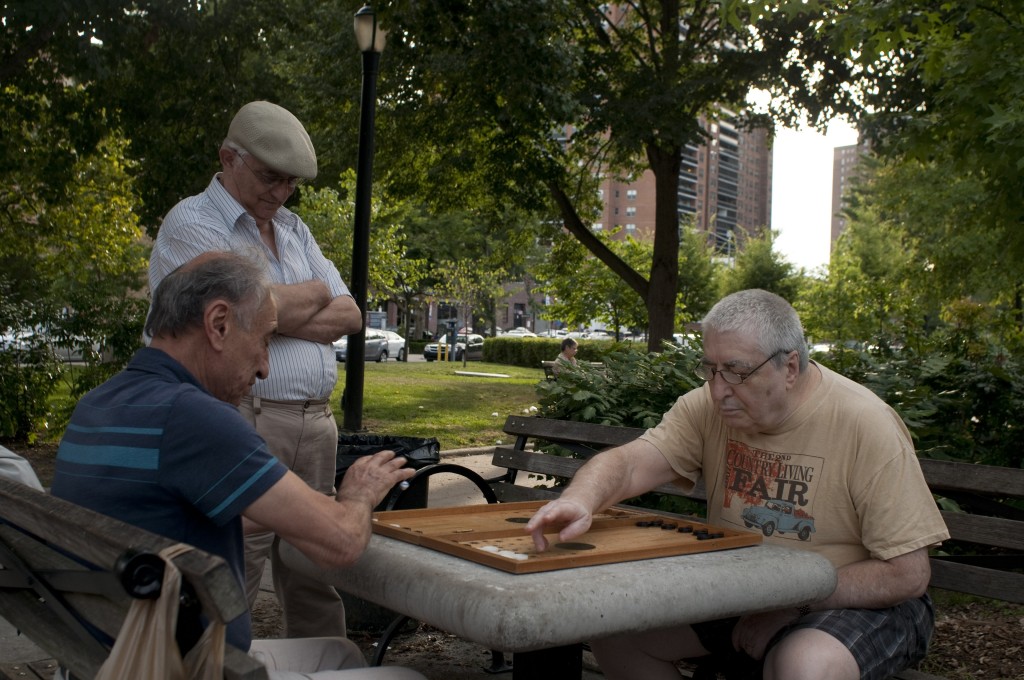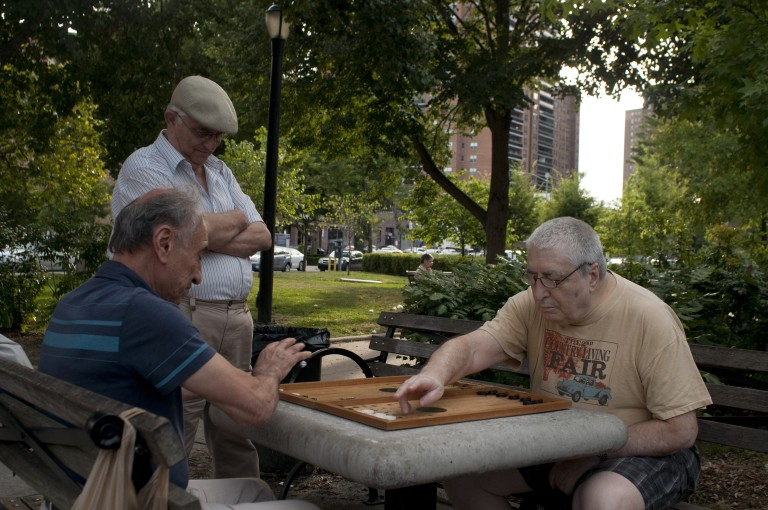
GregoriyIvyayev, Eddie Usupokov and Vladimir Vopian play backgammon in MacDonald Park in Forest Hills, Queens. Forest Hills, like many neighborhoods throughout Queens, have a large aging immigrant population that has a set of needs that will need to be met as they continue to get older Kate Bubacz/The Forum Newsgroup
As New York City ages, so does Queens. The borough is fortunate to have some of the most ethnically diverse neighborhoods in the world, but the graying population of immigrants may pose unique challenges to the community, according to a recent study released in July by the Center for an Urban Future.
The New York City-based non-profit think tank states that the population of older immigrants in Queens increased by 35% in the past decade. This study highlights that the shift in demographics requires a change in support systems for these aging communities in the coming years. The center’s report points out that elderly immigrants are more likely to be linguistically isolated, with less in savings and less able to receive the same benefits through Social Security and Medicare.
Both the state and the city have a labyrinth of agencies that receive state funding and provide services for everything from transportation to food stamps to disease management. The state provides money by program, not by organization, which allows communities flexibility of options, but can make it difficult for immigrants and the elderly to get proper information about what services are available.
“Call your elected officials,” state Sen. Joe Addabbo Jr. (D-Howard Beach) advised. “They will have more information, and will know of resources that can help an individual.”
On staff at Addabbo’s Middle Village office, for example, there is a constituent liaison who is fluent in Spanish and who helps people with government paperwork and applications.
For some, calling government officials can be too intimidating a task.
“At most sites, we are finding that there is a need to better serve immigrants,” says Nicole Vaughn, the director for Center Based Services at Queens Community House, a multi-service settlement house that is based in Forest Hills and has 22 different sites in 11 neighborhoods in the borough. It relies on funding from the city and state for the majority of its operations, which includes translation services, providing information about entitlement programs that people may be eligible for, such as Medicaid, and helping them apply.
“A lot of immigrants are scammed, because of the language barrier, or because they are low income, and they will come to us after being played elsewhere, sometimes in worse shape than they were before, and we will help them [it] out,” Vaughn says.
“It’s absolutely crucial for seniors from varying immigrant backgrounds to get services tailored to their specific needs,” said Assemblyman Andrew Hevesi (D-Forest Hills).
“If that doesn’t happen, it is much more likely that these people will become isolated and will not be taken care of properly, which is likely to cost the taxpayer as they become more reliant on emergency services,” he continued.
That is a goal that organizations like the Visiting Nurse Service of New York (VNSNY) seeks to avoid. The nonprofit has a staff that speaks more than 50 languages, and in Queens alone, 470 registered nurses plus dieticians, social workers and home health aides working to insure that none of its patients falls through the cracks. Many of their clients are referred by hospitals or doctors, and have multiple chronic illnesses that need management.
According to Susan Loo-Lee, a VNSNY Nurse Manager, the organization strives to match elderly immigrants with nurses and other staff members who speak their language, or ideally, are immigrants themselves from the same country who understand their cultural norms.
Eun Young Na, a South Korean immigrant herself, works as a registered nurse manager for VNSNY, coordinating the care of her patients with their doctors, home health aides, and any other support staff that their needs may require.
“We all work together as a team,” she says. “I am proud of this, that I can deliver the right care and I understand the cultural things, like food, their way of thinking, which is sometimes different from Americans. I can educate them better.”
By Kate Bubacz

